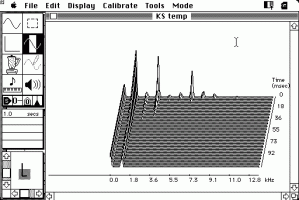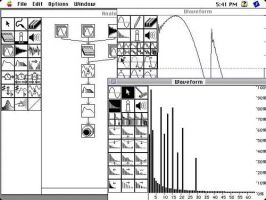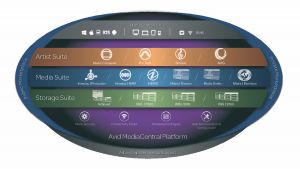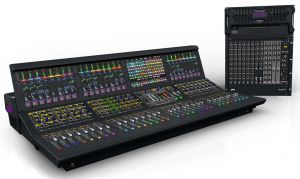 Many of us have personal relationships with Avid (and before that Digidesign) that go back many years. That relationships have taken many forms, from Sound Designer the first affordable sound editing software, to the initial cooperation with Opcode that produced the original DAW on the Macintosh, to the innovative SampleCel bus cards, to the powerful Venue live consoles. In the mid 90's Digidesign brought the first Pro Tools hardware/software systems to the market and the application has become the de-facto standard in recording studios. Most of the music you hear today was made with Pro Tools as part of the process.
Many of us have personal relationships with Avid (and before that Digidesign) that go back many years. That relationships have taken many forms, from Sound Designer the first affordable sound editing software, to the initial cooperation with Opcode that produced the original DAW on the Macintosh, to the innovative SampleCel bus cards, to the powerful Venue live consoles. In the mid 90's Digidesign brought the first Pro Tools hardware/software systems to the market and the application has become the de-facto standard in recording studios. Most of the music you hear today was made with Pro Tools as part of the process.
Tony Cariddi is a classic example of someone that started in the mail room (well, pretty close anyway) and has moved up the ranks to a position of major responsibility within the company. Today he is the Marketing Director of Audio at Avid. The company has gone through tremendous changes over the last few years, and Tony was kind enough to take the time to talk about some of the things the company is doing today.
Do you have a musical background?
I grew up playing guitar but don't play as often as I'd like these days. My office has tons of guitars in it and I occasionally dust them off and play. I was in bands and played in high school and college, and then I got interested in the recording and, because when we first went into a studio I was fascinated with what went on there. There was a guy named Bill Tesar, who had a rental company in New York City—his brother, Rave, recorded our album in high school. He had an early Sound Tools system and he was triggering all of these samples for us, and I just thought that was the most amazing thing. From there I kind of gravitated toward the more technical side and was just really fascinated with that side of it.
How did you get to Avid?
After college I moved to San Francisco, really for no good reason, and when I got out there I got turned on to what Digidesign was and realized—that was long before MBox 001—the personal stuff started at $10-12K back then, so it was really expensive, and I wanted it so badly. One day a friend said,"Hey, you know Digidesign is hiring and they're only about 35 miles south of here." And I said,"Really? Do they have an employee purchase program?"
They were hiring for a technical support gig, but I had no experience with the products, so I borrowed a bunch of manuals to prep for the interview. I read, from cover to cover, the Masterlist CD manual, the TurboSynth manual, Sound Tools, Pro Tools... But, as much as I tried to fake my way in, I didn't get the gig. They kind of saw through it. I kept trying and eventually ended up getting a job making phone calls to customers of the Sound Tools systems to ask them if they were interested in upgrading their hardware to Pro Tools.
What did you learn during that time?
I learned a lot. The early perception with Pro Tools was that you would never rely on that in a commercial environment. The stakes were too high. What was fascinating was, fast forward maybe three or four years, and in that seven-year stretch after that, was how the market really embraced it. Being at the forefront there, during that time and that transition from what, prior to that, was basically either you had the money and had a decent reel to reel, or if you were a broke musician like I was, you were using a portable studio based on cassette tapes.
Bringing those tools to the masses and watching them really disrupt the market and being right on the frontline of sales while that was happening was really a lot of fun. And there was so much innovation going on right in that immediate geographical area—I remember back when I was working in the Hillview office in Palo Alto, and I remember buying my Studio 4 directly from OpCode and driving over there after work one day to pick it up.
We were grateful of course. Jumping to today, how did Avid arrive at the decision to offer a Pro Tools subscription model?
Well, it's a trend in the industry for a good reason. The dynamics have changed for software companies just like the dynamics have changed for hundreds of other industries, including the music industry and media in general.
In the traditional approach, you would take an engineering team and you'd scope out what the launch was and you'd have to define in advance and you'd know you have to build in a certain amount of value into it in order to make it viable. And the lead time could be anywhere from twelve months to three years. And in that time there would be a perceived lull and customers would be scratching their heads and wouldn't necessarily see the innovation going on. And on the company side, they would be dealing with their own pressures because there would be long gaps between times when they could offer new products.
So what has happened is that a lot of companies have looked at subscriptions as a way to overcome these problems. First, it allows the engineering teams to be a lot more agile because it sets these shorter, more frequent milestones. The teams can be more efficient and pump out these really exciting innovations on a much more frequent basis. You still have to focus on providing value over the course of the term of the subscription, but as soon as the feature or capability or workflow is complete, it goes right out to the customers.
For the customer, it offers more value because they're seeing much more frequent updates. They're able to get a lot more value and more efficient workflow or whatever the innovation is bringing. So it's a steadier way to approach things on the business side, and it's also a way we can bring much more consistent and more frequent innovations to the market.
That's a good answer. How has the channel reacted?
The channel wants to make sure they are going to be a part of the business moving forward. And big part of our success in the past has to do with the fact we have worked closely with the channel over the years. So it was really critical that during this rollout that we were communicating really often and clearly with the channel to let them know that even though subscription is going to be part of the offering now, they're going to remain involved the whole way. We're not going direct like Apple or iTunes or Spotify type of a thing. We're continuing to sell the product as we did in the past.
So, you have announced a free version of Pro Tools...
You may remember something called Pro Tools Free that we did in 2000. It was received well, and obviously when you give something away for free, there has to be a goal for it. Will people buy the product if there's a free version? So it was something that was an exciting thing, and allowed us to get the software in the hands of an enormous amount of people and disrupt the market.
Today, the environment is different. We're not the first to do a Freemium offering, but in general freemium offerings are there to get a large number of people to try the product and to give them an easy way to become paying customers and to make the experience really, really good for them and just kind of open the floodgates to get as many people on the software as possible. For us, over the past few years you've heard a lot about Avid Everywhere and our vision of enabling content creators, but also to connect those content creators with each other and with their audiences in a more efficient, and collaborative profitable way. Pro Tools | First fits into this whole picture because for this platform to be successful, we need the industry to participate in it.
The fact of the matter is back in the day with Pro Tools Free the limitation was really that computers weren't fast enough and audio I/O was much more expensive. You needed some kind of hardware acceleration and quality I/O to do any real work. Today, the computers are really fast and audio I/O has been largely commoditized, so what's the limitation? If you look at the landscape, with GarageBand being given away for free, and other premium type options like Reaper, Reason, Ableton Live, there's a laundry list of affordable, powerful solutions available for content creation. And they're all pretty powerful, and they're fighting over the same group of people.
You've got this tool doing it this way and another doing it that way, but the market is saying these tools are all good enough and they're all pretty affordable. That's why Avid has to do something different here. That's why we're focusing on connecting our premium creative tools so workflow is easier, connecting our customers so they can uncover opportunities and work more creatively together, and connecting them to their media so that it's easier to find it, and for the owners of the media to be found.
Can you talk about your cloud initiative?
That's Avid Cloud Collaboration. It offers a way for people to get onto our platform and collaborate with some of the most successful people in the industry. It give them a focused platform where they can make new connections with others and uncover opportunities on our artist community. In this online community artists can connect with each other to find opportunities, whether that be creative opportunities, technical mixing jobs or editing jobs. It's also a place where people can get exposure for their work and also monetize their work. This idea of a connected solution is something that we're really going to be pursuing across Avid with all of the other creative applications.
The focus of Avid Everywhere is to not only keep innovating in the Artist Suite solutions—Pro Tools, Sibelius, VENUE, Media Composer—but also deliver new value in other places where other companies aren't. We're leveraging the community component. We're leveraging a platform where not only can Pro Tools users play, but now with this free new version—Pro Tools | First—everyone can get on this platform. So everyone can collaborate and work within this community, can get exposure and can monetize their music by selling their songs or skill set. And also, to provide a platform, which Apple can play and Ableton can play and all of these companies can play.
With so many great solution out there, why make people choose? Why make it hard for somebody using Logic and somebody using Cubase and somebody using Pro Tools to work together. Why not solve that problem? Those are among the biggest challenges people face today in this market. It's not as much about running out of tracks or not having the plug-in power. It's that they're having a hard time working with this person because of incompatibilities with software. It's that they need to efficiently distribute tasks across a team to get a job done more quickly. It's that they are struggling to get the next break and don't have the means to get exposure for their talents.
I have been living this because I'm finishing up a CD. The producer is a Pro Tools guy and we use different DAWs. What's happening now is he comes over here and he mixes with my DAW and he hates it because it slows him down. The problem is that there are a lot of plug-ins instantiated and he doesn't have the same stuff in his Pro Tools system. How will this make it easier for us to work together?
Well the first step is to create collaborative workflows within our own Pro Tools ecosystem. As you know we've announced Avid Cloud Collaboration for Pro Tools. We demonstrated how this works in Pro Tools at NAMM in January. In Pro Tools, regardless of what plug-in set somebody has, two people can be working in parallel and not have a version issue. Let's say you and I were both working on a project and you continue to use the sound on the plug-in on the bass tracks and change the setting on a variety of things and I did some editing on the playlists and maybe recorded a little bit and you and I are both touching the same element or different elements on the same track, how do we marry those changes back together again?
Because up until now, people are forced to use Dropbox or Google Drive. It's still a push-pull thing and you still have the issue of "I got your update, but I did changes too. How do we marry them? Did you keep track of what you did? Did you write it all down?"
Today, the way we're solving for that if two users with Pro Tools are trying to work together and inevitably one is going to have something that one doesn't, so the way we're addressing those issues is when you share a track, it's an attribute of the track, just like we have other attributes, like is it track based or is it sample based? This attribute will be if you want this track to be shared, and you have other options if you want to. When it's shared, you can have the audio, or the MIDI, or it can be an instrument track. You can have that shared as it is in your session, or frozen, or completely committed as a track. The way we solve it today is we just say if they don't have it you can just share it as frozen, that way if someone gets the plugin and then freezes it and then has a little more latitude to change the settings. If not, they can just use it as an audio track. So that's that. The next step might be opening these workflows to companies like Apple and Steinberg and Ableton through our Connectivity Partner Program.
Speaking for a lot of folks like me, it would be nice if you got a positive response. What do you think this means for plug-in developers?
What we've done across the Artist Suite applications, is unify the audio and video engines across Pro Tools, Media Composer, Sibelius and VENUE. What that means is they're all relying on the same audio plugins. All of our audio systems use AAX plugins. Our Media Composer video editing system uses AAX plugins. So one of the perks of developing for AAX is that you're accessing a larger market now across the audio/video broadcast space. Some companies like Nugen have done a great job leveraging that opportunity already.
Is there anything else you would like to say?
We believe in the artist. For us the Avid Artist Community is really the central social platform for people to share their work, to find people to work with, potentially offer their services, potentially sell songs and that kind of thing, and it could that eventually this could be the main hub for their media life. So you've got Facebook for socializing and sharing more personal things, but we want creative people to have the Avid Artist Community for really connecting with the professional community.
The music products industry needs companies like Avid to thrive. They provide innovation and they sincerely care about their place in the pro audio market. It's their primary focus.

Find Pro Tools Ultimate in the KVR Marketplace








 Other Related News
Other Related News











